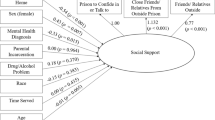Abstract
Social support theory is important in explaining inmate behavior within prison but has been largely ignored in the research. Using multilevel analysis, the study examined the effect of social support on inmate misconduct measured by disciplinary infractions in the 1997 Survey of Inmates of State Correctional Facilities in the United Slates. Findings indicate that several social support variables at both the inmate level and prison level affect inmate rule violations per month.
Similar content being viewed by others
References
Adams, K., Bennett, K.J., Flanagan, T.J., Marquart, J.W., Cuvelier, S.J., Fritsch, E., Gerber, J., Longmire, D.R., & Burton, Jr., V.S. (1994). A large-scale multidimen-sional test of the effect of prison education programs on offenders’ behavior.The Prison Journal, 74, 433–49.
Camp, S. D., Gaes, G. G., Langan, N. P., & Saylor, W. G. (2003). The influence of prisons on inmate misconduct: A multilevel investigation.Justice Quarterly, 20, 501–533.
Cao, L., Zhao, J., & Van Dine, S. (1997). Prison Disciplinary Tickets: A test of the deprivation and importation models.Journal of Criminal Justice, 25, 103–113.
Carlson, B. E., & Cervera, N. (1992).Inmates and their wives, incarceration and family life. Westport, CT: Greenwood.
Colvin, M., Cullen, F. T., & Vander Ven, T. (2002). Coercion, social support, and crime: An emerging theoretical consensus.Criminology, 40, 19–42.
Cornwell, B. (2003). The dynamic properties of social support: Decay, growth, and staticity, and their effects on adolescent depression.Social Forces, 81, 953–978.
Cullen, F. T. (1994). Social support as an organizing concept for criminology: Presidential address to the Academy of Criminal Justice Sciences.Justice Quarterly, 11, 527–559.
Cullen, F. T., Wright, J. P., & Chamlin, M. B. (1999). Social support and social reform: A progressive crime control agenda.Crime & Delinquency, 45, 188–207.
Flanagan, T. J. (1980). Time served and institutional misconduct: Patterns of involvement in disciplinary infractions among long-term and short-term inmates.Journal of Criminal Justice, 8, 357–367.
Flanagan, T. J. (1983). Correlates of institutional misconduct among state prisoners.Criminology, 21, 29–39.
Goetting, A., & Howsen, R. M. (1986). Correlates of prisoner misconduct.Journal of Quantitative Criminology, 2, 49–67.
Harlow, C. W., Snell, T. L., & Mumola, C. J. (1999).Survey of state and federal inmates, 1997. In Bureau of Justice Statistics (Ed.),Correctional populations in the United States, 1997 (pp. 47–70). Washington, DC: U.S. Department of Justice.
Harer, M. D., & Steffensmeier, D. J. (1996). Race and prison violence.Criminology, 34, 323–355.
Huebner, B. M. (2003). Administrative determinants of inmate violence: A multilevel analysis.Journal of Criminal Justice, 31, 107–117.
Jiang, S. (2005). The impact of substance use on inmate misconduct: A multilevel analysis.Journal of Criminal Justice, 33, 153–163.
Jiang, S., & Fisher-Giorlando, M. (2002). Inmate misconduct: A test of the deprivation, importation, and situational models.The Prison Journal, 82, 335–359.
Jiang, S., & Winfree, T. Jr. (2006). Social support, gender and inmate adjustment to prison life: Insights from a national sample.The Prison Journal (forthcoming).
Johnson, R. (2002). Hard time: Understanding and reforming the prison. Belmont, CA: Wadsworth/Thomason Learning.
Kreft, I., & de Leeuw, J. (1998).Introducing multilevel modeling. Thousand Oaks, CA: Sage Publications.
Lin, N. (1986). Conceptualizing social support. In N. Lin, A. Dean, and W. M. Ensel (eds.), Social support, life events, and depression (pp. 17–31). New York, NY: Academic Press, Inc.
Lin, N., Ye, X., and Ensel, W. M. (1997).Revisiting social support: Integration of its dimensions. Duke University: Unpublished transcript.
MacDonald, J. M. (1999). Violence and drug use in juvenile institutions.Journal of Criminal Justice, 27, 33–44.
MacKenzie, D. L. (1987). Age and adjustment to prison.Criminal Justice and Behavior, 14, 427–47.
Owen, B. (1998). “In the Mix”: Struggle and survival in a women’s prison. Albany, NY: State University of New York Press.
Paterline, B. A., & Petersen, D. M. (1999). Structural and social psychological determinants of prisonization.Journal of Criminal Justice, 27, 427–441.
Pollock, J. M. (2002). Women prison and crime. Belmont, CA: Wadsworth Thomson Learning.
Pratt, T. C., & Godsey, T. W. (2003). Social support, inequality, and homicide: A crossnational test of an integrated theoretical model.Criminology, 41, 611–643.
Raudenbush, S. W. & Bryk, A. S. (2002).Hierarchical linear models: Applications and data analysis methods. Thousand Oaks, CA: Sage Publications.
Wooldredge, J. D. (1991). Correlates of deviant behavior among inmates of U.S. correctional facilities.Journal of Crime & Justice, 14, 1–25.
Wooldredge, J., Griffin, T., & Pratt, T. (2001). Considering hierarchical models for research on inmate behavior: Predicting misconduct with multilevel data.Justice Quarterly, 18, 203–233.
Wright, J. P., Cullen, F. T., & Miller, J. T. (2001). The family social capital and delinquent involvement.Journal of Criminal Justice, 29, 1–9.
Wright, K. N. (1991). A study of individual, environmental, and interactive effects in explaining adjustment to prison.Justice Quarterly, 8, 217–242.
Zamble, E., & Porporino, F. J. (1988).Coping behavior and adaptation in prison inmates. New York: Springer Verlag.
Author information
Authors and Affiliations
Corresponding author
Rights and permissions
About this article
Cite this article
Jiang, S., Fisher-Giorlando, M. & Mo, L. Social support and inmate rule violations: A multilevel analysis. Am J Crim Just 30, 71–86 (2005). https://doi.org/10.1007/BF02885882
Issue Date:
DOI: https://doi.org/10.1007/BF02885882




